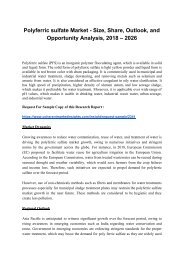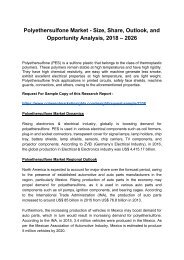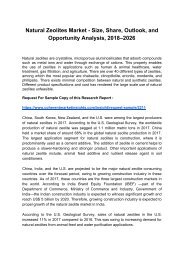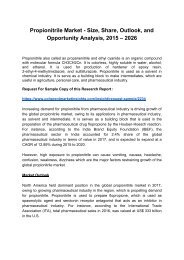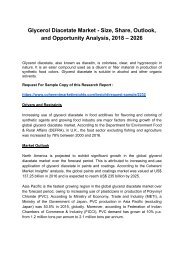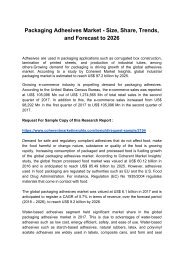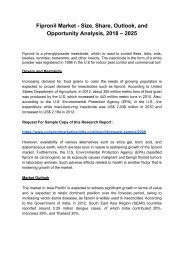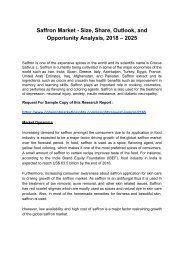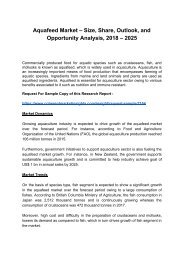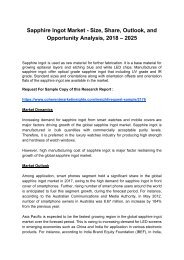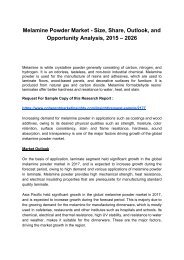Residue Hydro Desulfurization Catalyst Market
The research report on Residue Hydro Desulfurization Catalyst Market is segmented by Application, by End-Use Industry and by Region - Size, Share, Outlook, and Opportunity Analysis, 2018 – 2026
The research report on Residue Hydro Desulfurization Catalyst Market is segmented by Application, by End-Use Industry and by Region - Size, Share, Outlook, and Opportunity Analysis, 2018 – 2026
Create successful ePaper yourself
Turn your PDF publications into a flip-book with our unique Google optimized e-Paper software.
<strong>Residue</strong> <strong>Hydro</strong> <strong>Desulfurization</strong> <strong>Catalyst</strong> <strong>Market</strong> -<br />
Size, Share, Outlook, and Opportunity Analysis,<br />
2018 – 2026<br />
<strong>Residue</strong> hydro desulfurization is a procedure to remove sulfur, nitrogen, and other<br />
contamination from natural gas and refined petroleum products including fuel oil,<br />
diesel fuel, and others. As sulfur dioxide (SO2) is responsible for increasing pollution<br />
in the environment, the process reduce SO2 emissions from fuels. These fuels are<br />
majorly used in vehicles, aircraft ships, gas & oil burning power plants, fuel<br />
combustion, railroad locomotives, residential & industrial furnaces.<br />
Request For Sample Copy of this Research Report :<br />
https://www.coherentmarketinsights.com/insight/request-sample/2342<br />
Furthermore, catalyst are used to demonstrate high desulfurization performance for<br />
light gas oil, kerosene and other which have high nitrogen concentration. Such oils<br />
are difficult to desulfurize including vacuum gas oil, FCC light cycle oil (LCO).<br />
<strong>Market</strong> Dynamics<br />
Implementation of stringent norms to reduce harmful emission from vehicle is paving<br />
the way for advanced emission control technologies in vehicles and engines, which<br />
is boosting demand for clean fuels such as ultra-low sulfur gasoline (ULSG) and<br />
ultra-low diesel fuel (ULSD). For instance, as per the national diesel sulfur standard<br />
prevailing in the emerging countries such as India is limited to 350 ppm, along with<br />
50ppm which is required to maintain in major Indian cities. Regulating bodies’<br />
measures to maintain sulfur standards for diesel and gasoline creates awareness in<br />
the market to reduce harmful emissions. These clean fuels are obtained by hydro<br />
desulfurization catalytic process.<br />
Furthermore, rising exposure of harmful air particulates such as sulfur oxide,<br />
nitrogen oxide, and others are propelling the residue hydro desulfurization catalyst<br />
market. Such exposure might cause serious health implications and lead to deaths,<br />
across the globe. This residue hydro desulfurization process lowers down the<br />
content of sulfur and nitrogen oxide, which would reduce fuel emission from engines<br />
and vehicles. According to Our World in Data, in 2015, Saudi Arabia, and Egypt<br />
witnessed highest levels of exposure to such particulates at 105 µg/m3, while
countries across Europe, Oceania, and North America had air particulate levels at<br />
5-10µg/m3. Moreover, according to World Health Organization, about 3 million<br />
people across the globe died due to ambient air pollution in 2012.<br />
Regional Outlook<br />
North America is expected to achieve significant growth in the market during the<br />
forecast period, owing to the stringent standards on gasoline volatility, benzene<br />
content, and diesel fuel aromatics content, which limits the exposure of harmful<br />
emission via residue hydro desulfurization catalyst. For instance, in 2016, the U.S.<br />
implemented diesel and gasoline sulfur standards of 30 ppm (average) and 10 ppm<br />
(cap), respectively.<br />
Asia Pacific is expected to sustain lucrative growth rate in the residue hydro<br />
desulfurization market during the forecast period. This is attributed to rising pollution<br />
related deaths in the region. The residue hydro desulfurization catalyst process<br />
reduces the amount of sulfur content in the petroleum products, which in turn would<br />
reduce the harmful emissions. According to the Our World in Data, South Asia,<br />
Southeast Asia, and East Asia witnessed about 3 million deaths due to exposer to<br />
harmful emissions in 2016.<br />
Key Players in the <strong>Residue</strong> <strong>Hydro</strong> <strong>Desulfurization</strong> <strong>Catalyst</strong> <strong>Market</strong><br />
Key players operating in the market include CRI <strong>Catalyst</strong> Leuna GmbH, Redkino<br />
<strong>Catalyst</strong> Company, Albemarle Corp, Honeywell UOP, Johnson Matthey PLC, Haldor<br />
Topsoe A/S, Clariant AG, Chevron Phillips Chemical Company, W.R. Grace & Co,<br />
Axens S.A., and others.<br />
Major players adopt various business strategies such as mergers & acquisitions,<br />
new product launches, and product development to gain strong foothold in the<br />
market. For instance, in 2016, S-Oil partnered with General Atomics Electromagnetic<br />
Systems (GA-EMS), to provide electrostatic separation technology and equipment<br />
for its installation in residue upgrading complex (RUC) in Onsan refinery complex in<br />
Ulsan, South Korea.<br />
For More Information: https://tinyurl.com/y4xsre7p
About Coherent <strong>Market</strong> Insights:<br />
Coherent <strong>Market</strong> Insights is a prominent market research and consulting firm offering<br />
action-ready syndicated research reports, custom market analysis, consulting<br />
services, and competitive analysis through various recommendations related to<br />
emerging market trends, technologies, and potential absolute dollar opportunity.<br />
Contact Us:<br />
Mr. Shah<br />
Coherent <strong>Market</strong> Insights<br />
1001 4th Ave,<br />
#3200<br />
Seattle, WA 98154<br />
Tel: +1-206-701-6702<br />
Email: sales@coherentmarketinsights.com





